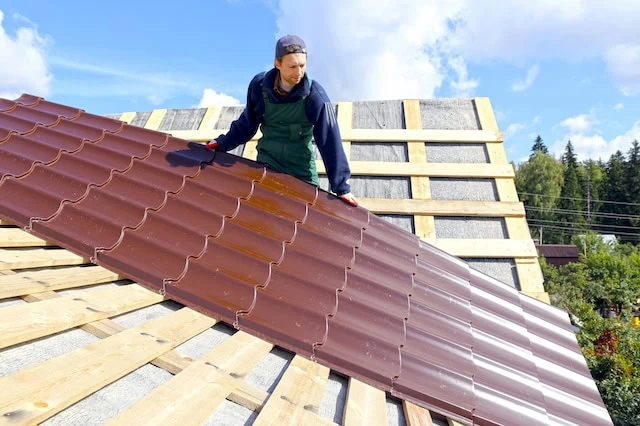Homeownership comes with many financial and emotional benefits. But wow, can it be a major hassle, particularly if you choose a fixer-upper.
No matter the case, there’s a good chance you’ll need to work with a contractor at some point. But unfortunately, when you work with contractors, there’s a chance you might get scammed.
According to a 2023 JW Surety Bonds Survey, roughly 1 in 10 Americans have fallen victim to a contractor scam. That’s not a high percentage, but it’s still a costly gamble—these victims lost an average of $2,426. For many people, that sum could make or break their budget.
Today, then, I’m going to discuss popular contractor scams—and how to avoid them to ensure you remain in that unviolated 90%. Once you know how to sniff out scammers, you can make sure you get the work you asked for at the price you agreed upon.
Featured Financial Products
Table of Contents
Common Contractor Scams

Sometimes, it’s obvious a scammer is trying to pull a fast one. But in some cases, the scams are much more subtle—and you might not even realize you’re getting ripped off for months, even years.
No matter how long it takes for a scam to reveal itself, you should know the warning signs so you can avoid them altogether.
Here are a few of the most common scams, along with some advice on how you avoid falling victim to them.
1. Taking a Large Deposit, Then Disappearing

The scam: In this blatant scam, the fraudster collects a large deposit from you and never returns. You’re simply out that money. Usually, the supposed contractor will have completed little to no work.
How to avoid the scam: If a contractor requests to be paid in full upfront, consider that a red flag. Although a deposit might be standard for some types of home improvement projects, a request to be paid a very high percentage or all of the overall cost isn’t. Consider only paying an upfront deposit of 20% or less of the total project value. Also, never pay your deposit in cash or through a prepaid debit card.
Additionally, it can help to check if the person has a legitimate and positive online presence. Respondents to a Service Direct survey said the top methods they typically use when researching a home contractor were:
— Asking a friend in person (68%)
— Google (51%)
— Better Business Bureau (31%)
— Yelp (20%)
— Facebook (18%)
Ideally, you can use a contractor that a trusted friend or family member vouched for. But when that’s not an option, online reviews can be helpful. You can also check to see whether a contractor is licensed by asking for their license number and checking your state’s website.
Related: 10 Most Expensive Cities to Buy a House In
2. Being Told You Need Work Done That You Don’t

The scam: In this scam, the contractor contacts you, rather than the other way around. You’re told that you need work done, and lucky you, they’re just the person to handle it.
Let’s say there’s a large storm one night. The next day, a contractor knocks on your door. The person says they were in the area working on someone else’s roof and noticed yours had a lot of damage from the storm. They offer to repair it for you at a reasonable price, and you agree. As it turns out, your roof was fine and didn’t need any work done.
How to avoid the scam: In this scenario, consider seeking additional opinions. Not every contractor is out to scam you, and the honest ones will let you know if you don’t currently need work done. You might have to pay a small fee for the consultation, but that’s better than paying much more for unnecessary work.
You also could have friends or family who are more knowledgeable than you about the type of repair, you could ask them to take a peek. It’s a fair option if money’s tight, but it’s a lesser alternative to having a professional check things out.
Related: Should Retirees Move? 10 Considerations
3. Not Using the Agreed-Upon Materials

The scam: This scam is subtle, and you might not even realize what happened until it’s too late … if ever.
The contractor says they’re using high-quality materials for your project; for instance, you might agree on an expensive type of paint known for good coverage and durability. Instead, the contractor uses a cheap paint—which is more prone to damage and might necessitate frequent touchups—that results in poor coverage and fading color over time. It’s a fresh coat of paint, though, so you only notice that it looks better than what you had. You pay the contractor the agreed-upon price, and you don’t realize you were ripped off until it’s way too late.
How to avoid the scam: Request receipts for the materials used. If you’re around when the work is being done, you can also inspect the materials to verify it’s the right products. Another option is to buy the materials yourself.
Featured Financial Products
Related: 10 Cheapest Places to Buy a House
4. Cost Creep

The scam: You do your homework before hiring a contractor. You know approximately how much the project should cost, and you fielded quotes from multiple contractors before hiring one. You’re comfortable with the price and confident it’s reasonable for what needs to be done. At first, everything seems good and orderly.
But then the costs start to rise. Issues pop up. Something the contractor didn’t see in the initial inspection will require more hours. They underestimated the amount of materials needed for the job.
This is a tricky one, because your contractor could be lying to inflate the cost now that you’ve already hired them and started the job—but they also could be telling you the truth.
How to avoid the scam: Don’t trust verbal cost estimates. Always try to get a written quote and have a contract signed before any work begins. You still might end up paying more than you originally thought—say, by 10% to 20%—but the written quote could prevent you from absorbing outrageous increases.
If the contractor wants to formally raise the costs a substantial amount and have you sign a new document while the work is already being done, it might be worth getting a second opinion. If you aren’t informed that the price has risen until after the work is complete, insist on an itemized bill (which actually must be provided in some states). You can check the bill for any signs the worker spent more than was discussed.
Related: 10 High-Paying Jobs That Are Dying (Or Evolving)
5. Skipping Steps

The scam: People typically hire a contractor for one of two reasons (or both):
1. They can’t complete the job (at least to the desired skill level).
2. They don’t have time to complete the job.
For these reasons, a contractor can sometimes get away with skipping steps in a project as long as the end result looks presentable.
For example, a painter might not prime walls to save time and skimp on materials costs. When you’re presented with the finished project, it looks fine. However, that skipped step could result in fading color, or chipped or peeling paint, down the road.
How to avoid the scam: You can avoid this scam by educating yourself on the steps the contractor should be taking. Then, you can regularly check to ensure the proper steps are being followed. Checking reviews is useful too, as some people think to update their reviews if they ever find out a task wasn’t performed as well as they originally thought.
Related: 20 Expenses to Cut From Your Budget in 2024
6. Insurance Fraud

The scam: You need a project completed, but the cost is beyond your means. The contractor offers to talk to your insurance company directly to explain why your insurance should cover the expenses. No one likes haggling with an insurance company themselves, so this suggestion sounds appealing. However, this gives the contractor the opportunity to lie about a covered event and commit insurance fraud in your name.
How to avoid the scam: There are two ways to avoid this scam:
1. A contractor offering to deal with your insurance company doesn’t need to automatically set off alarms. Some contractors will actually do this for you and keep everything legal. If you go this route, however, talk to your insurance provider along the way to ensure the contractor has made legitimate claims.
2. Alternatively, you can turn down the offer altogether and work with your insurance company on your own.
Related: 9 Financial Mistakes That Can Quickly Drain Your Retirement Savings
7. Loan Fraud

The scam: This is another situation that might arise when you can’t afford a contractor’s quote. Obviously, for aesthetic work, you could simply put the project on hold. However, you might have a project that needs to be completed soon for safety reasons or to prevent further damage. The contractor claims to know a lender that can give you a great deal. Unfortunately, once you sign with the alleged lender, you discover the person is actually a scammer who took out a home equity loan on your house before disappearing.
How to avoid the scam: To avoid this scam, work with lenders directly through a bank or credit union. This takes more work on your part, and you might not get ideal terms, but it ensures the loan is legitimate.
Related: Do Installment Loans Build Credit?
How to Budget for Home Repairs

Even if you don’t get scammed, home repair costs can sometimes feel astronomical. It’s best to budget for these costs rather than be caught off guard.
Homeowners should try to save between 1% to 4% of their home’s value each year for repairs and regular maintenance. However, the actual percentage should be somewhat dependent on your home’s age. You can expect an old farmhouse built in the 1920s to require more work than a new home built last year. If your home is younger than 10 years old, 1% could suffice. If it’s older than 30 years, 4% might be more appropriate.
You might store money you expect to spend on repairs in a liquid, interest-bear account, such as a high-yield savings account. Alternatively, you could add extra money to your emergency fund. Or, you might also consider purchasing a home warranty that will cover repairs and replacements for systems and appliances.
Without savings or a warranty, you might need to get a personal loan or home equity line of credit. While these options aren’t terrible, your personal loan could have a cumbersome interest rate, and not making payments on a home equity line of credit could result in foreclosure.
Featured Financial Products
Related: 12 Best Long-Term Stocks to Buy and Hold Forever
As even novice investors probably know, funds—whether they’re mutual funds or exchange-traded funds (ETFs)—are the simplest and easiest ways to invest in the stock market. But the best long-term stocks also offer many investors a way to stay “invested” intellectually—by following companies they believe in. They also provide investors with the potential for outperformance.
So if your’e looking for a starting point for your own portfolio, look no further. Check out our list of the best long-term stocks for buy-and-hold investors.
Related: Best Target-Date Funds: Vanguard vs. Schwab vs. Fidelity

Looking to simplify your retirement investing? Target-date funds are a great way to pick one fund that aligns with when you plan to retire and then contribute to it for life. These are some of the best funds to own for retirement if you don’t want to make any investment decisions on a regular basis.
We provide an overview of how these funds work, who they’re best for, and then compare the offerings of three leading fund providers: Vanguard, Schwab, and Fidelity.
Related: 9 Best Monthly Dividend Stocks for Frequent, Regular Income

The vast majority of American dividend stocks pay regular, reliable payouts—and they do so at a more frequent clip (quarterly) than dividend stocks in most other countries (typically every six months or year).
Still, if you’ve ever thought to yourself, “it’d sure be nice to collect these dividends more often,” you don’t have to look far. While they’re not terribly common, American exchanges boast dozens of monthly dividend stocks.
Please Don’t Forget to Like, Follow and Comment

Did you find this article helpful? We’d love to hear your thoughts! Leave a comment with the box on the left-hand side of the screen and share your thoughts.
Also, do you want to stay up-to-date on our latest content?
1. Follow us by clicking the [+ Follow] button above,
2. Subscribe to The Weekend Tea, our weekly newsletter to read more about investing, spending, taxes, and more, and
3. Give the article a Thumbs Up on the top-left side of the screen.
4. And lastly, if you think this information would benefit your friends and family, don’t hesitate to share it with them!






